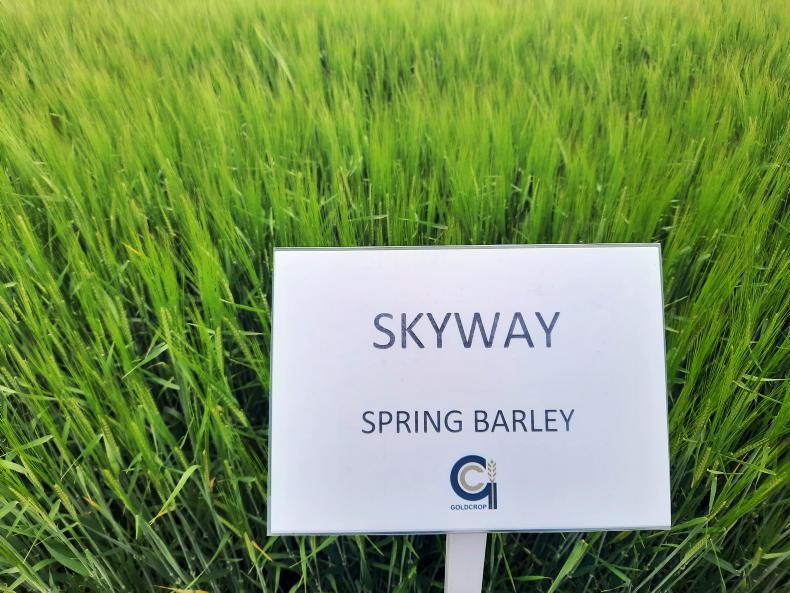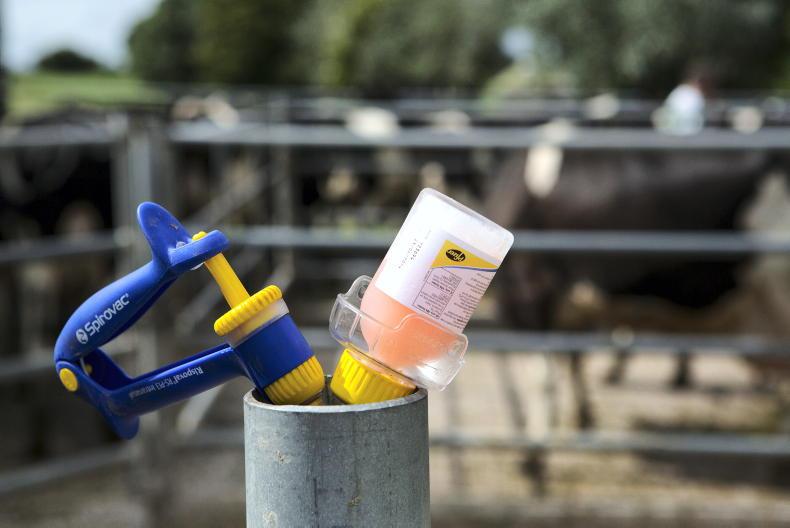One of the most important tools we have at our disposal to reduce fungicide use is variety choice. Varieties are a key part of a good integrated pest management (IPM) strategy, and it is important that we use them appropriately and treat them differently.
When choosing a variety, a grower should examine all characteristics, eg to see if it suits the end-use, but they should also put a focus on agronomic characteristics rather than just looking at the relative yield figures.
Choosing a variety that has good resistance to a disease can dramatically reduce the risk which that disease poses to a crop and its yield.
For example, spring barley varieties all carry a resistance score of eight against mildew.
Mildew is very easily controlled in spring barley as it does not get into crops as easily, and if it does, it can generally be controlled or kept away by using standard chemistry with no need for a specific mildewcide.
But some parts of the country are more prone to certain diseases.
For example, yellow rust can often be more prevalent in the east of the country, so growers there really need to think about planting varieties with good resistance to yellow rust.
Choosing appropriate varieties can also help to reduce the use of plant growth regulators.
Straw strength is a characteristic that is extremely important when choosing a variety, as those susceptible to lodging and straw breakdown may need more plant growth regulators and fungicides to combat this.
However, it is also good practice to have a number of varieties on farm.
This allows the workload to be spread out over time. Different varieties have different growth stage and ripening times. Having a number of varieties also gives some insurance, because if one variety performs badly in a season (either yield- or quality-wise), others will normally perform better. Some crops do not allow for this, such as malting barley.
Having to have more than one variety of a certain crop across the farm may limit one’s choice for a suitable package of varietal characteristics where a specific market is being targeted.
As it is unlikely that any one variety will be strong on all characteristics, it is important to examine and know the positive and negative traits of all varieties you are growing on your farm and to treat these appropriately.
For example, if you have three different spring barley varieties on the farm, it is safe to say that they should not all be treated the same. One may not require any plant growth regulator, while another may need a strobilurin to combat net blotch infection. They should not all receive the same treatment, otherwise you will not be efficient with plant protection products and you could be spending more money than needed.
Straw strength
Planet and Skyway are two varieties to watch out for in terms of lodging risk, both with scores of five. They also score quite poorly on straw breakdown with a score of four. Growth regulator might be suitable for these crops, depending on the season and, of course, products suited for specific end-uses.
There are limits on the use of some growth regulators depending on the grain’s end-use. Keeping crops clean will also play a big role in helping straw strength.
Disease resistance
A number of varieties including Gangway, Planet and Errigal have a score of five for resistance to rhynchosporium, so this is one to look out for. However, it will be catered for across most suitable disease control programmes.
Planet scores quite poorly for resistance to net blotch, so those growing this variety should be thinking about including a strobilurin in the fungicide mix.
Net blotch is becoming a difficult disease to control and there is an ongoing risk of resistance buildup to many fungicides.
All oat crops will need a robust growth regulation plan. Husky falls behind Isabel for resistance to lodging and straw breakdown, but both score similarly for disease resistance.
WPB Duncan is a spring variety to watch in terms of lodging, despite the fact it is the second shortest variety on the list. KWS Helium scores a five for both septoria and yellow rust, so it needs attention there. WPB Escape falls down on sprouting, so it is one to watch if you are planting late.
Straw strength
All winter barley varieties should be monitored closely for straw strength.
However, LG Casting rates at just a five for resistance to lodging and straw breakdown.
Many varieties score a six for these two characteristics as well, so plenty of caution is needed when it comes to plant growth regulator application and potassium (K) applications. Bazooka and Bordeaux also score a five for straw breakdown, so plant growth regulation and disease prevention are key to keeping these varieties standing for longer.
Disease resistance
Some of the winter barley varieties fall down on mildew with scores of five, so it is important to keep mildew at bay rather than having to treat it. Cassia, Infinity, Joyau and Bordeaux are on a score of five for the disease.
Cassia falls down particularly badly on Rhynchosporium with a score of five. However, when a good control plan is in place to prevent the disease, it can be kept at bay, so timing is everything with this variety.
Get out early with fungicides before disease has emerged.
Casting and Bordeaux are also on scores of five.
Straw strength
Graham comes in at a five for straw breakdown on the winter wheat list, and there is a lot of variation across the varieties for lodging and straw breakdown. A good plant growth regulator programme should combat this.

Irish Seed Trade Association open day winter barley and Mayflower winter wheat.
Disease resistance
Torp stands out for its susceptibility to mildew on the winter wheat list, while most varieties score very poorly for resistance to septoria. Robust programmes are needed here, as demonstrated by Steven Kildea and Tom McCabe in other parts of this magazine.
JB Diego and Torp are very susceptible to yellow rust, while Graham is one to watch for fusarium, and would benefit from a well-timed headspray. But getting that timing right is extremely difficult.
Varieties are an important part of IPM.Individual varieties have different characteristics.Different varieties help spread risk.Varieties should be treated differently to reduce the use of plant protection products.If we treat all crops the same without accounting for variety, we are not saving on plant protection products.
In this publication, the Department of Agriculture’s Cereal Variety and Evaluation team describes some of the work it does and how these trials change over time to adapt to current scenarios, such as examining BYDV-tolerance in barley and controlling septoria without chlorothalonil.
One of the most important tools we have at our disposal to reduce fungicide use is variety choice. Varieties are a key part of a good integrated pest management (IPM) strategy, and it is important that we use them appropriately and treat them differently.
When choosing a variety, a grower should examine all characteristics, eg to see if it suits the end-use, but they should also put a focus on agronomic characteristics rather than just looking at the relative yield figures.
Choosing a variety that has good resistance to a disease can dramatically reduce the risk which that disease poses to a crop and its yield.
For example, spring barley varieties all carry a resistance score of eight against mildew.
Mildew is very easily controlled in spring barley as it does not get into crops as easily, and if it does, it can generally be controlled or kept away by using standard chemistry with no need for a specific mildewcide.
But some parts of the country are more prone to certain diseases.
For example, yellow rust can often be more prevalent in the east of the country, so growers there really need to think about planting varieties with good resistance to yellow rust.
Choosing appropriate varieties can also help to reduce the use of plant growth regulators.
Straw strength is a characteristic that is extremely important when choosing a variety, as those susceptible to lodging and straw breakdown may need more plant growth regulators and fungicides to combat this.
However, it is also good practice to have a number of varieties on farm.
This allows the workload to be spread out over time. Different varieties have different growth stage and ripening times. Having a number of varieties also gives some insurance, because if one variety performs badly in a season (either yield- or quality-wise), others will normally perform better. Some crops do not allow for this, such as malting barley.
Having to have more than one variety of a certain crop across the farm may limit one’s choice for a suitable package of varietal characteristics where a specific market is being targeted.
As it is unlikely that any one variety will be strong on all characteristics, it is important to examine and know the positive and negative traits of all varieties you are growing on your farm and to treat these appropriately.
For example, if you have three different spring barley varieties on the farm, it is safe to say that they should not all be treated the same. One may not require any plant growth regulator, while another may need a strobilurin to combat net blotch infection. They should not all receive the same treatment, otherwise you will not be efficient with plant protection products and you could be spending more money than needed.
Straw strength
Planet and Skyway are two varieties to watch out for in terms of lodging risk, both with scores of five. They also score quite poorly on straw breakdown with a score of four. Growth regulator might be suitable for these crops, depending on the season and, of course, products suited for specific end-uses.
There are limits on the use of some growth regulators depending on the grain’s end-use. Keeping crops clean will also play a big role in helping straw strength.
Disease resistance
A number of varieties including Gangway, Planet and Errigal have a score of five for resistance to rhynchosporium, so this is one to look out for. However, it will be catered for across most suitable disease control programmes.
Planet scores quite poorly for resistance to net blotch, so those growing this variety should be thinking about including a strobilurin in the fungicide mix.
Net blotch is becoming a difficult disease to control and there is an ongoing risk of resistance buildup to many fungicides.
All oat crops will need a robust growth regulation plan. Husky falls behind Isabel for resistance to lodging and straw breakdown, but both score similarly for disease resistance.
WPB Duncan is a spring variety to watch in terms of lodging, despite the fact it is the second shortest variety on the list. KWS Helium scores a five for both septoria and yellow rust, so it needs attention there. WPB Escape falls down on sprouting, so it is one to watch if you are planting late.
Straw strength
All winter barley varieties should be monitored closely for straw strength.
However, LG Casting rates at just a five for resistance to lodging and straw breakdown.
Many varieties score a six for these two characteristics as well, so plenty of caution is needed when it comes to plant growth regulator application and potassium (K) applications. Bazooka and Bordeaux also score a five for straw breakdown, so plant growth regulation and disease prevention are key to keeping these varieties standing for longer.
Disease resistance
Some of the winter barley varieties fall down on mildew with scores of five, so it is important to keep mildew at bay rather than having to treat it. Cassia, Infinity, Joyau and Bordeaux are on a score of five for the disease.
Cassia falls down particularly badly on Rhynchosporium with a score of five. However, when a good control plan is in place to prevent the disease, it can be kept at bay, so timing is everything with this variety.
Get out early with fungicides before disease has emerged.
Casting and Bordeaux are also on scores of five.
Straw strength
Graham comes in at a five for straw breakdown on the winter wheat list, and there is a lot of variation across the varieties for lodging and straw breakdown. A good plant growth regulator programme should combat this.

Irish Seed Trade Association open day winter barley and Mayflower winter wheat.
Disease resistance
Torp stands out for its susceptibility to mildew on the winter wheat list, while most varieties score very poorly for resistance to septoria. Robust programmes are needed here, as demonstrated by Steven Kildea and Tom McCabe in other parts of this magazine.
JB Diego and Torp are very susceptible to yellow rust, while Graham is one to watch for fusarium, and would benefit from a well-timed headspray. But getting that timing right is extremely difficult.
Varieties are an important part of IPM.Individual varieties have different characteristics.Different varieties help spread risk.Varieties should be treated differently to reduce the use of plant protection products.If we treat all crops the same without accounting for variety, we are not saving on plant protection products.
In this publication, the Department of Agriculture’s Cereal Variety and Evaluation team describes some of the work it does and how these trials change over time to adapt to current scenarios, such as examining BYDV-tolerance in barley and controlling septoria without chlorothalonil.











SHARING OPTIONS